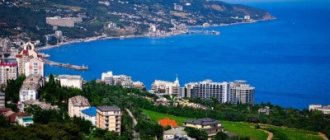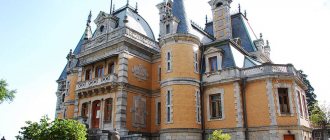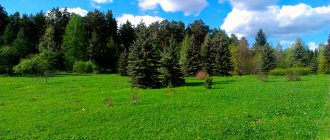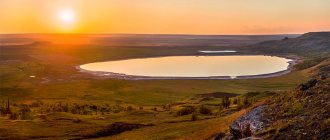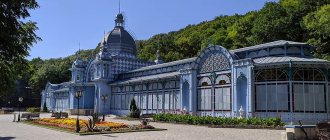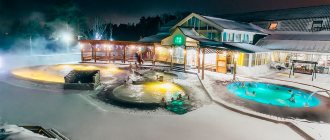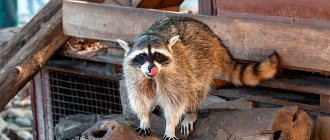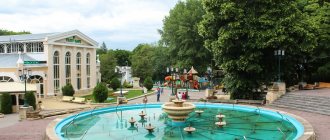| Park "Crimea in Miniature" Khan's Palace Complex Holy Dormition Monastery Chufut-Kale Salachik Quarter Bakhchisaray Sphinxes Kachi-Kalyon and the Beaded Temple Stories and reviews from tourists Where to stay in Bakhchisaray |
One of the most popular cities in Crimea among tourists is not by the sea. The former capital of the ancient Khanate is endowed with the epithets “garden-palace” by vocation and “city of five centuries” by its rich, multifaceted history. It is for her that travelers rush here, trying to be sure to include Bakhchisarai in their program.
The most attractive part for guests is its eastern half - the old city with colorful streets and unusual houses. Along the street Lenin and its continuation street. Gasprinsky there are its main attractions, and this route is compiled according to the logic of movement with some recommendations on the order of visits. General information about the city is presented on its separate page.
There are few top places directly in Bakhchisarai. This is the Khan's Palace, the Staroselye quarter with a historical complex, the Assumption Cave Monastery and then Chufut-Kale. However, each of them deserves either close attention or immersion in the atmosphere, so there is practically no need to choose the best for a one-day visit. At the same time, the full range of emotions from the historical, cultural and natural heritage is guaranteed. Objects that are distant in a different direction and require more travel time are listed last.
All sights of Bakhchisarai
On the corner of Lenin and Pushkin streets Photo: © Katerina Klimkina
Due to the location of the main “thing to see” on one street, the path is convenient to make during a walk or by transport. Pedestrians can only be advised to save energy for a walk by using the only buses No. 2, minibus No. 3 or taxi between points between points along Lenin and Gasprinsky, because without taking into account the winding inspection, the one-way path from the local bus station is about 7 km.
Park "Crimea in miniature"
The Bakhchisarai miniature park is one of several largest on the peninsula. All the must-visits of Crimea are traditionally collected here - palaces, mansions, museums, train stations. You will certainly get acquainted with the Swallow's Nest, Vorontsov and Livadia palaces, as well as the Khan's residence of Bakhchisarai itself. Reduced by 25 times, they allow you to immediately see all the splendor of the architectural heritage of the Republic, and an hour and a half story from a local guide will enlighten you about historical moments.
In addition, there are beautiful human-sized colored sculptures of cartoon characters and areas where children of all ages can frolic - labyrinths, trampolines, a climbing wall and a rope town. There is no review that does not write about the wonderful zoo, whose animals are well-groomed and live in free enclosures.
The park is located at the beginning of the street. Lenin, on the way from the bus station to the Khan's Palace. It is well worth a couple of hours, especially if you are traveling with a child. It is possible to visit it immediately upon arrival or postpone it until the evening - opening hours and illumination of objects will easily ensure this idea, because the real beauties of Crimea await ahead, which are best viewed in daylight.
Inner courtyard of the Khan's residence Photo: © Ekaterina Savvina
Kuibyshevo-Vysokoe Highway
Do you like to find locations from your favorite films in real life? Then you will definitely like the idea of visiting the highway between the villages of Vysokoye and Kuibyshevo.
It was here that one of the episodes of the Soviet film Prisoner of the Caucasus was filmed. Remember the moment when Shurik met Edik, whose car was constantly stalling? And how did he first meet Nina? This is where these scenes were filmed.
Next to the highway is Mount Utyug, which has the same shape. If you climb the mountain, you can get to a natural observation deck, from where you can see Kuibyshevo and its surroundings.
Khan's Palace complex
The Bakhchisarai Palace is the main pearl of the city, to which it owes its appearance, and the only living representative of the palaces of the Crimean Tatars. Its construction began in the 16th century. one of the Geray khans, subsequently supplemented by various objects under other rulers. A large-scale alteration was carried out, for example, by Potemkin before the visit of Catherine II. Since the beginning of the 20th century. appears as a museum since the 60s. and to this day, restoration is being carried out in it, aimed at returning to the original version.
Bakhchisarai, which translates as “garden-palace”, is rich in gardens with fountains, arousing the admiration of tourists for the well-groomed nature and size of the roses. The charm of Ottoman architecture with its individual features can be seen among several main buildings of the residence, the Golden Cabinet , as well as the kitchen, harem, stables, and library . They now house exhibitions of the Museum of History and Culture of the Crimean Tatars . From the XVI-XVII centuries. We have reached the large Biyuk-Jami mosque, the Sary-Gyuzel bathhouse, the Khan's cemetery with two tombs of the Gerays and the Dilyary-bikech durbe in the southern half of the courtyard, which do not in the least awaken doubts among visitors that they are genuine. On the Garden Terraces at the very end of the territory there are other memorials dedicated to participants in various modern military conflicts.
Khan's Palace Photo: © byzantine
The palace complex belongs to the Bakhchisaray Museum-Reserve (BIKAMZ). Tickets are available for self-guided and guided tours. Entrance is through the Northern Gate on the street. Lenin. Before continuing your journey, it is convenient to have a snack in the vicinity of the palace - there are a dozen cafes along the road, and also choose a souvenir in local shops.
On the way towards Chufut-Kale there is another exhibition, interesting for those interested in the topic. The Ismail Gasprinsky Memorial Museum tells about the famous educator, researcher, founder of new cultural ideas in Islam and is located in house number 47 on the street named after him. At the beginning of the street. There is a monument to Lenin, and throughout Crimea there are many more places that honor his achievements.
Palace interiors Photo: © Natalya Semchina
Fountain courtyard
In 1733, in the courtyard, next to the Small Palace Mosque, the “Magzub” (“Gilded”) fountain with gilded ornaments and relief inscriptions was built. This fountain was intended for ritual ablution before prayer.
Fountain Magzub
Much more famous is another fountain, which looks much more modest in appearance. The “Fountain of Tears”, praised by Pushkin, appeared in the courtyard in 1764. Initially, it stood in the tomb of the wife of the old Khan Delyare. When Catherine II arrived in Crimea, it was moved to the palace Courtyard of Fountains.
According to legend, the hard-hearted Khan Kyrym-Girey fell madly in love with Delyare Bikech. The title "Bikech" indicates that Dilyare was a court housekeeper. It is believed that she became the khan's favorite wife, but was poisoned by another wife. Shocked by her death, the khan ordered Delyare to be buried in a mausoleum specially built on the territory of the palace complex, and ordered a fountain from the Iranian master Omer, the stone of which was supposed to cry.
The “Fountain of Tears” is a small wall structure with a carved pediment and bowls located one below the other. Water from the hole in the shape of a flower trickles drop by drop into the upper bowl, then gradually pours into the lower ones. The result is the impression of tears flowing down the stone.
Fountain of Tears
During his southern exile in 1820, Pushkin visited the Khan's Palace. This visit inspired him to write the poem “To the Fountain of the Bakhchisarai Palace” and the poem “The Bakhchisarai Fountain”. It should be noted, however, that in both works of Pushkin, instead of the real-life Delyare, the fictional Polish concubine Maria appears, who also fell victim to intra-harem intrigues.
In the upper bowl there are always two roses - dark and light, which are placed there by palace employees. This pays tribute to the beginning of Pushkin’s poem “The Fountain of the Bakhchisarai Palace”: Fountain of love, living fountain! I brought you two roses as a gift. I love your non-silent conversation and poetic tears.
Bust of Pushkin next to the Fountain of Tears
Holy Dormition Monastery
In the Maryam-Dere valley, starting from Staroselye, there is a monastery significant for Orthodoxy - the Crimean Lavra, the Assumption Anastasievsky or Holy Dormition Monastery . For some, the very stay in the sacred place will be important here, associated with the miracle of the appearance of the Icon of the Mother of God, while others will be struck by the unusual location. Part of the monastery is skillfully built among the rocks, which makes it difficult to understand whether it is growing out of them or the steep slopes of the gorge are steadily and slowly capturing the shrine in their embrace.
Its history combines alternating periods of prosperity and desolation. As with many religious things in the former USSR after the ban in the 1930s, a gradual revival occurred in the early 1990s. Now on two rocky and lower levels there are several temples and churches, there are outbuildings and a guest house for pilgrims, the territory is beautifully landscaped and is being built up with new objects. A staircase leads to the amazing cave cells and temples, the Holy Assumption Church in particular, which often appears in tourists’ photos.
Monastery complex Photo: © Polina Shegurova
Criminal situation
About Bakhchisarai you can say the good old proverb “The fish rots from the head.” Petty thieves are foolish children compared to the city leadership. The level of bribery exceeds all possible limits. The system is built in such a way that you pay at all stages: when you cross the threshold of the clinic, you pay for tests, for visiting a doctor. The same situation is with kindergartens and schools. In order to enroll a child in kindergarten, you need to pay 600 - 700 dollars, not counting the constant fees for repairs, cleaning supplies, etc.
At the clinic, the director gathers doctors and says who should collect how much for a month of charity... At the same time, no one is interested in how the doctor will talk about money to the patient (doctors are also different), and if you don’t take it from people, then you have to give it from your salary, and she is small. Charity money in a minimum amount is passed through the bank's cash desk.
The level of corruption is catastrophic.
Apart from petty thefts, there were no major crimes in the city.
Chufut-Kale
In the vicinity of Bakhchisarai there are several cave cities - Chufut-Kale, Tepe-Kermen, Mangup-Kale, Eski-Kermen, Kachi-Kalyon, Bakla. All of them are truly unique and interesting, although they have a common similarity and there will be no disappointment about missing out. The optimal route for the day is Chufut-Kale , located literally at the end of one of the city streets. You can get to it either on foot (2 km from the Staroselye terminal) or by car.
Chufut-Kale is a narrow plateau between two valleys at the eastern outskirts of Bakhchisarai, on the top of which there are the remains of the ruins of ancient buildings and caves . It is not known for certain about its first inhabitants, name and features. The history from the 14th century, when its settlement by Karaites began, until the end of the 19th century, was studied in more detail. - after permission to resettle them in other places.
Walls and roads of the Karaite fortress Photo: © Ekaterina Savvina
Now you can find a well, ruins of a mosque, prayer buildings (kenassas) and baths, parts of walls and gates, former roads and the only surviving house of the local culture researcher A.S. Firkovich. On both sides of the hill there are colorful views of green gullies and ridges, the most impressive being Mount Besh-Kosh with smooth steep slopes of limestone.
1.3 km south of the fortress there is another observation deck on the edge of the plateau. There are two paths leading to it: the right one goes through an abandoned Karaite cemetery in the forest, where you can see tombstones, the left one goes along a more well-trodden country road.
View from Chufut-Kale to Mount Besh-Kosh Photo: © Ekaterina Savvina
Donkey farm "Miracle Donkey"
Address : Zalesnoye village, Sovetskaya street 2a Website : https://osliki.com/
Donkey tour cost: from 300 to 2000 rubles (depending on the type of tour, each tour will necessarily include a sightseeing tour and obtaining a donkey driver document)
“Miracle Donkey” is the only farm in Russia where Somali and Nubian donkeys are bred. At the farm, each visitor can book a donkey tour, which includes:
- walk around the farm and meet the donkeys;
- a walk along one of the mountain routes (to the cave city of Eski-Kermen, to the foot of Mount Mangup or to the valley of the sphinxes of the Karaleska Valley);
- tasting of donkey milk (whether it will happen or not depends on the season);
- relaxation in the cherry orchard;
- visit to the petting zoo (geese, pheasants, peacocks, goats, ornamental chickens, Cameroonian oxen, Vietnamese pigs, horses and, of course, donkeys live here).
There is a cafe on site (every day from 9 a.m. to 10 p.m.) where you can have a tasty and satisfying meal. The cafe sells first, second, various salads, meat dishes, desserts and much more. The average bill per person is 600 rubles.
Children will definitely be delighted with the Miracle Donkey farm, because here they can spend the whole day with the animals and make friends with them. All animals are already accustomed to human attention, so they know how to get along with even the smallest visitors.
There is a large children's playground on the farm grounds. Therefore, children will have something to do and somewhere to run while adults eat or go about their business.
Salachik Quarter
Salachik, or later Staroselye, passes into the gorge between the steep walls of the plateau along the street. Basenko, which is a continuation of the street. Lenin and Gasprinsky. Its main attraction is the first palace of the Geray khans of the 15th century. Several buildings have been preserved on the territory, which are currently part of “Salachik” (another name is “Devlet-Saray” ), one of the historical and archaeological complexes of BIKAMZ. The location on the route from the main palace to the Assumption Cave Monastery and Chufut-Kale gives a chance to see it before them or on the way back.
Guests can see a well-preserved dyurbe with underground and above-ground tiers, elaborate architectural carvings and a massive dome. The burials of members of the Geray family were allegedly found in it. Zyndzhirly madrasah survived , anyone entering which had to bow his head before the place of sacred science thanks to the chain hanging above the entrance. Today the building houses an exhibition of dishes from the southwestern Crimea (inspection upon request). of the Khan's baths appears in the form of ruins .
Sphinxes are an integral part of the city panorama Photo: © Andreydsms
Alushta - Simferopol - Kerch
From Alushta you can return to Kerch along the coast, through Feodosia. But we suggest you return through Simferopol to visit natural attractions along the way and avoid the difficult mountain serpentine between Alushta and Sudak.
Moving along the Alushta - Simferopol highway, turn into the village of Luchistoye and, leaving the car near the Golden Horseshoe equestrian club, walk along the slopes of the Demerdzhi mountain range to the Valley of Ghosts - a bizarre accumulation of rocks of unusual shapes.
Next, the road passes through the Angarsk Pass - a rather steep climb awaits you, for which you will be rewarded with picturesque views. If you have time and energy, along the way you can visit one of the interesting karst caves on the slopes of Chatyr-Dag. For example, from the village of Perevalnoye you can follow the sign for the Red Cave, drive to the parking lot and walk another 1.5 kilometers. The Red Cave (Kizil Koba) is a complex of underground halls with a length of 26 kilometers, along which a tourist route is equipped. An excursion route has also been created in the Marble Cave, but getting to it is more difficult. You need to get to the village of Zarechnoye, follow the signs to the village of Mramornoe (4 kilometers), and from Mramornoe drive another 8 kilometers along a dirt road to the entrance to the cave.
When choosing where to stop along the way, consider the time, because from Alushta to Simferopol it is almost 50 kilometers along a difficult route, traffic jams are possible in the Simferopol area, and from Simferopol to Kerch there are still more than 200 kilometers.
Bakhchisarai sphinxes
A place to visit depending on your desire and strength. Despite the location practically on the route, not far from the Khan’s Palace, in order to get closer and see them with your own eyes, you will need a detour of a kilometer and a half. Do not confuse the road if the navigator suggests something else: there are similar formations in the village. Zalesny, 20 km south of Bakhchisarai, these are the sphinxes of the Karalez Valley.
The stone sculptures of the work of water and wind on Mount Savlu-Kaya received a variety of names the sphinxes of the Churuk-Su valley - after the name of the city river, and Bakhchisarai women or menhirs - as a popular concept of similar objects among Turkic peoples, and pillars - by analogy with similar mountain formations, and the idols - by the presence of “faces” and similarity with the moai statues on the island. Easter. A ridge of huge boulders separating from the hill awakens the imagination and serves as an unusual backdrop for tourists’ photos. Those who come in the evening will be able to admire them and the panorama of Bakhchisarai in the glow of the sunset.
View from Kachi-Kalyon to the gorge of the same name Photo: © Polina Shegurova
Suatkan Waterfall
Address : village of Bogatoye Gorge (next to the bed of the Suatkan River)
Suatkan is translated from the Tatar language as “throwing out water.” And indeed, Suatkan is a rather powerful and full-flowing waterfall, its height is 13 meters.
The best time to go to see the waterfall is in the spring, as it dries up in the summer. Getting to Suatkan is quite difficult; you have to walk a lot. So it’s better not to take children on such a trip.
Suatkan is surrounded on all sides by virgin yew groves. Many unique flowers, rare herbs and other plants grow here.
Kachi-Kalyon and Beaded Temple
Kachi-Kalyon is another, no less impressive and extensive cave city at the foot of the Fytski plateau next to the Kacha River in the southern outskirts of Bakhchisarai. When viewed from the road, the scale of the massif with smooth walls and arches is very impressive. According to one version, the resemblance to the ship gave rise to its name, which is similar to the Spanish “galleon”. There is no reliable information, so based on a few signs, researchers can only assume the existence of a winery and a monastery in its grottoes. In front of the first and fourth niches, small temples of Hagia Sophia and Anastasia are carved into the rocks.
The light limestone slopes of Kachi-Kalon are very beautiful at sunset, but walking along the steep rocky paths requires caution, so you should not neglect comfortable shoes that secure your feet. If you have a car, getting to it is faster; the distance from the city center is about 8 km. Pedestrians will need buses going from the bus station to the village. Synaptic, you must ask the driver to get out in front of the village. Bashtanovka.
At the top of the mountain in an old quarry there is another attraction. The Skete of Anastasia the Pattern Maker or the Beaded Temple surprises guests with decorations made of beads and beads, on which candle lights play with warm light. This material was chosen as an alternative to paints that do not adhere well to limestone walls. All decorations have been made by monks and sympathetic parishioners since its creation in 2005. The history of the first monastery, which probably was in the rocks of Kachi-Kalyon, dates back to the 7th-8th centuries. Much about it is unknown, although its existence in the last century is similar to other religious sites on Russian territory.
It is easier for travelers by car to visit the shrine: they need to go around the mountain along the road from the village. Pre-Ultimate. For others there is a steep path from the road near Kachi Kalyon. The bus route, accordingly, is the same, and the on-demand stop should be designated at the first place visited. Temple visiting hours are limited to between 8 am and 8 pm.
Inside the Bead Temple Photo: © Katerina Klimkina
How to get there
It seems inappropriate to talk about how to get there by car. Because the distance between Bakhchisarai and Sevastopol and Yalta is about 40-45 km. In the latter case, however, owners of non-Jeeps will have to work hard. Since the shortest road runs through the Ai-Petri plateau and its quality at times leaves much to be desired.
Public transport, however, is much less convenient. From Yalta, for example, you will have to get through Sevastopol. And spend about 2.5 hours and more than 300 rubles on the road... per person! Coming from the hero city is much easier: about an hour on the road, you need to pay ~160 RUB for a ticket.
© Ashore.ru
Stories and reviews from tourists
There is no tourist who would complain about the facelessness of Crimea. On the contrary, most of its guests try to fit as much as possible into their vacation, because the versatility of its manifestations is endless. One-day visits are relevant in relation to Bakhchisarai; it is certainly included in the itinerary list. Reviews and stories will share fresh photos, emotions from what they saw and useful nuances in preparing for the trip. For example, details can be found in these reviews:
- Bakhchisarai: chebureks, palaces and cherubs - a photo album by Anastasia Buyanova about a trip there in winter;
- Crimea - a peninsula of “double standards” - a story from the author 96321 about a visit to Bakhchisarai during a trip around the entire peninsula;
- Tauride Voyage - Byzantie's story about a trip through Crimea and one day in Bakhchisarai;
- Bakhchisarai is a colorful photo album by Constantine about the ancient capital.
All tourist reviews about Bakhchisarai on Tourist. RU
Photo: © Anastasia Buyanova
Historical reference
Several settlements previously lived on the territory of Bakhchisarai. There was the fortress city of Chufut-Kale, the villages of Eski-Yurt and Salchak. The latter, by the way, was the capital of the Crimean Khanate until 1532. Sahib the first Garay built the khan's residence here and renamed Salchak Bakhchisarai. After the village received a new status, it began to grow rapidly and soon became a large city.
In the 17th century, there were already more than 2,000 houses in Bakhchisarai, and many Greeks lived in the city. During the Crimean Tatar War, the city was almost completely burned out. In the 19th and 20th centuries, Bakhchisarai was the center of social and cultural life of the Crimean Tatars. After the mass deportation of Tatars during the Second World War, the city was significantly deserted.
Where to stay in Bakhchisarai
Bakhchisarai is rarely chosen as the main place of residence in Crimea, coming here for the day with an excursion or on its own. However, if you plan to thoroughly explore the town and all the mountains in the surrounding area, you can stay in one of the dozen guest houses located in the area of the Khan’s Palace and Lenin Street. Some of them are distinguished by oriental flavor - traditional architecture and cozy shady courtyards. While relaxing in them, you will temporarily immerse yourself in the measured way of local life.
- Bakhchisaray Hotels
- Hostels for Budget Travelers
- Flats and apartments
- Guest houses in Bakhchisarai
When checking availability for specific dates on Booking.com, be sure to check the “I am traveling for work” checkbox. Otherwise, room reservations will not be available.
A way to save on travel is to book accommodation on Booking.com with cashback Cashback promotion on Tourist. RU
Food
Bakhchisaray is famous for its traditional cuisine. Popular dishes of Crimean Tatar cuisine:
- Chebureks and yantyki with cheese or meat
- Pilaf, shish kebab, lagman (thick soup with meat) and manti (similar to large dumplings)
- Khash - meat soup
- Yufkhash - tiny dumplings
- Bakla shorbasy - lamb soup with beans
- Silkme - usually lamb with vegetables
- Samsa in tandoor with meat and kubete (meat pie)
- Sweets: baklava, sherbet, Turkish delight
Martian lake
Address: along the Simferopol - Bakhchisarai highway
Lake Martian is a very beautiful place. Its total length is approximately 500 meters, its width is 200 meters and its depth is 10 meters. Because of the azure-colored water, it looks more like a piece of ocean in the middle of the desert.
In fact, there used to be a large quarry on the territory of the lake where limestone was mined. After it was dug, workers discovered a powerful spring. During active mining, water was pumped out using pumps. In the 90s, work was suspended, so the pumps were also turned off. In just a few days, the quarry was filled with water, and all the working equipment remained at its bottom.
Many locals and tourists often come to the lake to relax. For this purpose, the area near the lake was equipped with parking spaces, special recreation areas and attractions. Some people even swim in the lake, although this is officially prohibited for safety reasons.
Historical Sevastopol: from the Greeks and Taurians to the present day
Chersonese Tauride
Walking through the ruins is a special pleasure, because many centuries ago merchants, warriors, and children ran on these stones. In Chersonese Tauride, which first belonged to the ancient Greeks, then to the Pontians, then to the Roman Empire and Byzantium, the remains of dwellings, an ancient theater, and a medieval temple have been preserved.
The city has come a long way from a democratic slave-owning republic to a stronghold of Christianity, where Prince Vladimir was baptized, and then all of Rus'. Now Chersonesos is a nature reserve, where excavations are still underway. On its territory there is a museum and in the center - the single-domed Vladimir Cathedral.
Maksimova dacha
Address: Ekaterininskaya Street How to get there: from the railway station bus 17, minibuses 17, 20, 25, 26, trolleybuses 17, 20 – to the “Hospital Complex” stop. There, transfer to bus 12 (or walk 2 km) to the Maksimova Dacha stop.
Everything here is permeated with the sad revolutionary and military events of the 20th century. The history of this estate began at the end of the 19th century with the decision of Alexey Andreevich Maksimov, a construction contractor, and in the future the mayor of Sevastopol, to build an estate for his family. The couple and their children were happy here for only a short time, before the sad events of 1905, but they managed to build several beautiful buildings with columns, terraces, plant trees, create ponds and gardens.
After the suicide of the head of the family in 1908, the dacha, like the whole family, was haunted by misfortunes. Both sons were killed, one of them in his father’s house. In a cozy estate, the new government massively “destroyed the bourgeoisie as a class,” and during the Great Patriotic War the Germans came here and again soaked the land with blood.
Formally, Maksimova Dacha is a nature reserve, but in fact, summer residents and barbecue lovers have greatly damaged what has survived so far. However, picturesque ruins, if you know their history, can make you think about life and once again rejoice at the peaceful times in which we live.
Skel menhirs
Address: s. Rodnikovskoe. From Sevastopol, from the railway station to the stop “5th kilometer of Balaklava Highway” there are buses No. 17, minibuses 17, 20, 25, 26, trolleybuses 17, 20. From the 5th kilometer to the village. Rodnikovskoe buses No. 37, 41, 182, 183.
If you want to delve into the primitive history of Sevastopol and its environs, be sure to go to the village of Rodnikovskoye. Menhir (long stone) is the first human architectural structure on the Crimean Peninsula.
These huge monolithic stones (weighing about 6 tons) most likely had cult significance. However, no quarries were found nearby, which suggests manual transportation of these blocks from afar. How did our ancestors do this? Probably the same way they built the pyramids, the statues on Easter Island and the Great Wall of China.
Touch one of the menhirs - they were touched by the hand of an ancient, primitive man. It is through such monuments that the connection of centuries is restored.
Streets with history:
The Count's Marina is located on Admiral Nakhimov Square. Considered the main entrance to Sevastopol from the sea, it is decorated with wide steps and columns with the date of creation. The guard houses have been preserved. They say that if you put your palm in the mouth of one lion (any one) and make a wish, it will definitely come true.
The embankment of Sevastopol is Primorsky Boulevard, Kornilov, Klokachev and Crystal Beach embankments. The length is more than two kilometers. On the route you will see monumental architecture, cliffs, a monument to sunken ships, a dolphinarium, and a sundial.
Story
Khan-shed
Khan-Saray, the khan's palace itself, has not survived to this day in its original form. Considering the turbulent military history of Bakhchisarai, it is good that it has been preserved at least in its current form. In 1736, the Russian troops fighting here, led by Field Marshal Munnich, came, according to Munnich, “to such a heart” that they burned the palace to the ground and cut down the famous hanging gardens. Then the palace was rebuilt several times and destroyed again, and the last Crimean Khan, Shagin-Girey, going into honorable exile in Voronezh and never dreaming of returning to his homeland, took everything from the palace that was of any value. They tried to restore the Khan's residence several times, mainly in anticipation of the next imperial visit. But the long-standing Russian practice of emergency patching of holes has made the palace's condition even more deplorable. “Our everything” Alexander Pushkin, being in these places, wrote that he felt great annoyance at the neglect in which the palace was decaying. Gradually, Khan-Saray risked turning into a real barn. However, in the 60s of the last century they finally took it seriously. Now it is an integral architectural ensemble, where you can see the buildings of the palace, the tower in which the learned falcons were kept, a mosque, a family cemetery, the mausoleum of the beloved wife of Khan Crimea-Girey, the harem premises and, most importantly, a fountain courtyard with the famous Fountain of Tears, which has forever entered Russian history culture through the efforts of the poet Pushkin.
Cave fortress city Chufut-Kale
The city is located on the small Burunchak plateau and is surrounded by deep gorges. The natural landscape and fortress walls ensured the safety of the settlement; getting here was very difficult. The only way was a mountain path that connected the inhabitants with the rest of the world.
To this day, four-tiered battle caves connected by internal passages have been preserved at the Southern Gate of the city. Caves-cellars, water pipes, remains of city blocks, defensive walls and temples were also discovered.
Several ancient fortifications have been preserved in Bakhchisaray, the most unusual of which is the cave fortress city of Chufut-Kale. Scientists believe that it arose back in the 5th–6th centuries and at first it was mainly Alans who lived here. Chufut-Kale does not look like a fortress as we imagine it. Here all the structures were carved right into the rocks. In the western, most ancient part of the city, caves that were used for household needs, the ruins of a mosque and the mausoleum of the daughter of Khan Tokhtamysh have been preserved. Later, Karaites began to settle in the city. Now the Crimean Karaite community is restoring ancient kenasses here - religious buildings, and in the preserved residential estate you can learn about the culture of the Karaites.
Alma Battlefield
The Alma battle became the prologue to the heroic defense of Sevastopol, which lasted 349 days: “On Alma, on September 8, 1854, the armies met for the first time, which were to attract the attention of the whole world for 11 months; on the field of the Alma battle, these armies collided for the first time, and nine thousand human beings fell as the forerunners of the destruction of half a million lives at Sevastopol.” The Alma battlefield is a place that was glorified by the Crimean War
The first major field battle of this campaign took place here. Russian troops here blocked the path to Sevastopol for the combined forces of England, Turkey and France. In this battle, the Russians lost 5,700 people; enemy losses were comparable - 4,300 people killed and wounded. This is despite the fact that they had a significant advantage both in technology and in people - almost threefold. The Battle of the Alma River did not end in favor of the Russians; they retreated. But the enemy, exhausted from the battle, did not pursue them. This helped us gain some important days
The Alma battlefield is a place that was glorified by the Crimean War. The first major field battle of this campaign took place here. Russian troops here blocked the path to Sevastopol for the combined forces of England, Turkey and France. In this battle, the Russians lost 5,700 people; enemy losses were comparable - 4,300 people killed and wounded. This is despite the fact that they had a significant advantage both in technology and in people - almost threefold. The Battle of the Alma River did not end in favor of the Russians; they retreated. But the enemy, exhausted from the battle, did not pursue them. This helped us win several important days.
Crimean Astrophysical Observatory
Address: PGT NauchnyPrice: children's ticket - 150 rubles, adult ticket - 300 rubles (excursions are held after 19:00, Sundays are a day off) Telephone numbers for ordering excursions: +7978-893-54-11 and +7978-806-13- 74
The Crimean Astrophysical Observatory is a real monument to Russian astronomy. Initially it was located on Mount Koshka near the village of Simeiz. But during the war, the building was completely destroyed, all the equipment was damaged.
Then, after the end of the war, it was decided to restore the observatory and move it to another place (just to the village of Nauchny). Leading scientists of the USSR worked at the Crimean Astrophysical Observatory, so its importance for domestic science cannot be overestimated.
Today, the observatory is no longer so revolutionary. But it is open to the public and there are excursions every day. They are led by qualified guides who will tell visitors about the history of the observatory and celestial bodies. Visitors are also allowed to watch the stars through professional equipment.
